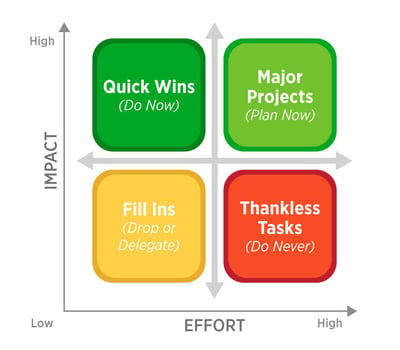
Brilliant and creative enrollment professionals, we know your pain.
So many great ideas, so little time, and so little budget.
It’s the refrain of higher education (that, and “Don’t talk to me during application season”). And while we know you want to tackle everything with an enthusiastic “yes”, saying “no” more often than “yes” is nearly always required to keep your institution and your strategy on track.
With budget season inching towards the finish line, we know you’re already thinking about putting that budget into action in the new fiscal year. We also know that making the most of that budget will require focus, a concrete plan, and most importantly, that discipline to say “no” to lots of shiny new ideas that pass you by.
Steve Jobs said it best: “Deciding what not to do is as important as deciding what to do.” But with great ideas and options coming at you from all sides, how do you decide what will maximize value for your institution?
With this enrollment cycle murkier than ever and past performance clearly not indicative of future success, turning your gaze on some downhome marketing truths is a good idea.
Read on for five key questions to ask yourself next time that lightbulb moment hits you and your team. Our insights will help you hone your efforts on the ideas that will produce results and justify that budget.
1. How does this idea support my institution’s goals?
Ideas that lead to actionable strategic initiatives start here (at least if you’re hoping to get some budget from the powers that be).
Consider how your idea ladders up to initiatives at various institutional levels (institution at large, department, team, etc.). And while it may sound simple, defining exactly what you are trying to accomplish with this idea and why can be surprisingly difficult.
A pretty puzzle piece that doesn’t actually fit the puzzle you’re working on is just that, pretty…useless. The same rule applies here. Envisioning that goal state and working your way backwards can help you say “no” to shiny ideas that ultimately lead to nowhere. Working toward that clearly articulated, shared goal also keeps your team aligned, motivated and well-primed to dismiss the inevitable distractions that will pop up along the way.
2. How does this idea support my customer’s needs?
Broadly speaking, your customers are your students and their parents — those paying the tuition bill that your institution sends them.
But it is important to get specific here. Your segmented student and parent audiences have their own specific needs (think domestic regional, domestic distant, international by country, non-traditional, and first year/undergraduate/graduate, start-date, program of interest, financial capacity, ethnicity, etc.). Before moving a new idea to the “Yes” pile, make sure you can clearly articulate how this idea serves a specific need for a specific audience segment.
And if you aren’t exactly sure what your students are looking for, we can help you identify student needs and differentiators through our quick, targeted market research projects.
3. How does this idea fit into the broader market?
Let’s make one thing very clear — just because everyone else is doing it, does not mean you need to do it, i.e., No, your institution does not need to be on TikTok. The fear of missing out never served anyone well, especially when it comes to making strategic decisions.
Institutional goals and customer needs are first on our list for a reason. Putting those things at the forefront of your decision making will allow you to cut through the broader market noise and focus on what will drive results for your specific brand. And while it is important to remain aware of how your institution’s offerings stack up against your peer institutions, when it comes to the initial evaluation of your ideas, it’s wise to keep your eyes on the road ahead before turning to that rearview mirror.
Another important clarifier — though it feels safe to rely on tactics you’ve used in the past, your data likely is indicating a diminishing return. You've been watching that, right? You, or whomever has your job next, is going to have to make that tough decision to try something new to stop the enrollment pain.
New technology platforms, new staffing structure, new marketing channels, new messaging — these all need to be evaluated. Case in point: How is that student list purchase delivering for you? You know, the one that all of your competitors have also purchased.
When it comes time to evaluate the ideas and options, relying on industry expertise, experience and data is essential. We’re here when you are ready.
4. How much effort does this idea require?
So, you’ve got a handful of brilliant ideas that align with your institution, your students, and the broader market (great), BUT those brilliant ideas will require time and budget that you don’t have (not so great).
It’s time to get strategic about your prioritization.
A helpful tool when considering your plan of attack is the oft-cited Impact Effort Matrix which can help you quickly and easily visualize where to spend your team’s valuable time and resources to maximize the impact for your business or institution.

- High Impact/Low Effort: These are your “Quick Wins”, the low hanging fruit projects to tackle quickly for maximum results.
- High Impact/High Effort: These are “Major Projects” or larger strategic initiatives with higher resource and planning costs, but costs that you anticipate will produce strong returns (you’ll probably find most of your ideas fall in this category).
- Low Impact/Low Effort and High Effort/Low Impact: These are "Fill Ins" and "Thankless Tasks" filled with things that likely aren’t worth your time.
- Pro Tip: It can’t hurt to keep some "Fill Ins" hanging around your to-do list if you need that quick “check!” rush of accomplishment to keep you and your team going. 😁
While we stand by this tool and regularly recommend it as a resource for strategic enrollment management planning, it should not be used in a vacuum. The reality: humans are notoriously bad at anticipating the actual level of effort required to complete a task, as well as its impact.
Which brings us to the final question...
5. How will I measure success?
A spark of brilliance turned full-blown transformational strategy lives and dies on a measurable goal.
Ask yourself — can the impact of this idea be measured, and if so, how?
Before committing to the idea, ensure that you have specific and timebound metrics to keep you and your team on track. And if you’re struggling to establish success metrics for your idea, you likely still have some work to do on how and where it fits into your institution’s goals.
Success metrics can inform that “Impact” axis and your prioritization of ideas (e.g. a 2% lift in conversion rate produced from re-working your existing lead generation form will produce X number of new leads vs. a 5% lift produced from creating a new, really engaging, downloadable content offer.)
And the best part of well-defined success metrics? They can justify your next big idea to leadership come next budget season. And help you know when to celebrate a job well done.
A final tip: Get some perspective
We get it, saying “no” to ideas is often easier said than done, especially when you throw institutional politics into the mix. Your CFO, who has to say “no” to so many things, may have a thing or two to say about this.
Getting external perspective can prove invaluable to the planning process, especially when it comes with a track record of (measurable) results and deep market knowledge.
We know you and your team have a bunch of brilliant ideas kicking around, and Intead is here to be your sounding board and advisor. So many platforms, student engagement tools, marketing approaches, and digital channels to evaluate. From the quick wins to the major projects (strategic development for the long-term), we’ll help you develop a plan that justifies your budget every time and delivers results.
Just the expert, collaborative team you need to stay focused, create a plan, and execute.
Schedule a free 30-minute consultation with our team here.



